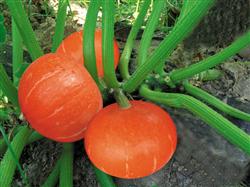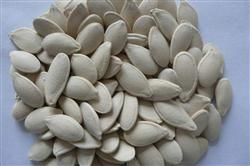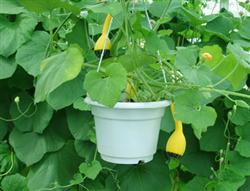How to plant and manage red chestnut pumpkin?

How to plant and manage red chestnut pumpkin? Please introduce the method that red chestnut pumpkin can be planted and eaten, adjust the diversity of varieties in the vegetable market, and can also be cultivated as ornamental and green plants in the main places. The cultivation methods are as follows: 1 the young red chestnut pumpkin is light yellow and white, and gradually deepens with the increase of melon age, the mature old melon has orange-red skin and orange-red flesh. When the young melon diameter 5cm, you can see 10 light white vertical lines, the whole pumpkin is symmetrically divided into 10 equal parts, with the increase of melon age, the vertical line widens and becomes more obvious. Mature melon is flat and round, its horizontal diameter is mostly in 20cm, high 12~16cm, and its appearance is beautiful and beautiful. The seed cavity is small and the seed coat is yellow, which is smaller than other pumpkin seeds. Mature melon weighs about 1~2kg per unit. Under natural conditions, it can be stored for more than 80 days. The plant grows creeping, the stem vine is round and stout, and the leaf color is dark or light because of the different soil fertility. The leaf is round, the diameter is mostly in 25cm, and the maximum diameter is 40cm. The internodes of melon seedlings are 15~25cm. (2) the biological characteristics of red chestnut pumpkin are strong in disease resistance, stress resistance and adaptability, and grow well in black soil, loess, Huangshan sandy soil, meadow soil and other soils. When the soil fertility is uniform and fertile, the size of the melon is more uniform. The length of seedling vine is 2.5m~6m, and the soil fertility is fertile, and the length of only one main vine can exceed 10m. Each main vine can grow 1 to 5 lateral vines (seedlings) in the process of growth, and both main vines and lateral vines have the ability to bear melons. There are 1 to 3 melons per plant. Red chestnut pumpkin is a hybrid generation of seeds, in principle, the seeds harvested after planting should not be used again next year. 2 the cultivation method of red chestnut pumpkin can be planted in a large area. It can also be intercropped with tall crops such as corn, sorghum or sunflower with a row spacing of 45.5m, and can also be planted in the rows of 4 -, 5-and 8-year-old fruit trees. Red chestnut pumpkin can be planted in cold open field, seed direct seeding or seedling transplanting, plastic film mulching cultivation and management, or planting in protected land. 2.1 Seedling mulching plastic film mulching cultivation is an important measure to obtain high yield. According to the termination date of the local late frost, the seedlings should be raised in the greenhouse or small plastic arch shed in advance and planted in the open field immediately after the late frost. Before raising seedlings, the soil for raising seedlings should be prepared. 6 parts of field soil and 4 parts of fully mature farm manure should be mixed and screened, or humus mountain soil, waste materials of cultivated Auricularia auricula and mushrooms or rotten lees leftovers should be mixed into the field soil and used as seedling culture soil after sieving. These mixed hybrid soils can make seedlings grow strong and root system developed. The diameter of the seedling bowl is 8~10cm. Load the sifted fine soil into 2 and 3 places in the seedling bowl and put it neatly and set aside. Before sowing, soak the selected red chestnut pumpkin seeds in a container, soak them in hot water for 50 ℃ and stir them with a stick to lower the water temperature to room temperature, soak for another 3 to 5 hours, then remove the seeds to accelerate germination and keep the temperature at 25: 30 ℃. The seeds can be sown as soon as the white tip of the seed is exposed. Put 1 seed flat in each seedling bowl, cover the soil with 3cm and water thoroughly. The temperature is controlled at 25: 30 ℃ in the daytime and about 15 ℃ at night. After the cotyledons are unearthed, the watering times should be reduced, the temperature should be controlled below 25 ℃, and attention should be paid to ventilation to prevent the seedlings from overgrowing. 2.2 Red chestnut pumpkin cultivated in open field can be prepared in autumn or spring, and it is better to prepare soil in autumn. Before preparing the soil, apply as much fully mature farm manure as possible, and then plough it so that the manure and soil are fully mixed and ridged away from 60~65cm. Melon seedlings planted in the open field should be planted in time after the late frost. If one ridge is empty and one ridge is planted, the plant spacing is 50cm / 60cm; if each ridge is planted, the plant spacing is 100cm. After ploughing (hole), 15-20g diammonium phosphate should be applied to each hole as the base fertilizer, and the base fertilizer should be mixed well with the soil to prevent root burning. Then put in the seedlings with dirt, pour enough water and cover the soil. Cover the plastic film, press the edge of the film firmly with soil, punch holes to expose the seedlings, and then seal the seedlings with soil to prevent the wind from blowing through the plastic film. The mature period of plastic film mulching is 20 to 30 days earlier than that of non-plastic film mulching. The extra income is 1-1.5 yuan per kilogram. 2.3After direct seeding, diammonium phosphate 15g / 20g was applied as the base fertilizer. In order to prevent the seeds from being burned by fertilizer, the fertilizer can be covered with soil and then sowed, sowing 1 grain per hole, covering the soil with about 3cm. The holes in each ridge should be interlaced with each other. (3) for the melon seedlings planted in field management and covered with plastic film, the seedlings grew faster after slow seedling because of the increase of ground temperature. When the seedlings grow to 100cm height, press a shovel of soil at the 80cm internodes, and then with the extension of the seedlings, press a shovel of soil every other 100cm, so that adventitious roots grow at the internodes to help absorb nutrients and prevent the strong wind from overturning the seedlings. All the young melons in the 10 leaves are removed. When the second or third young melon on this main vine is 5cm in diameter, five leaves are left on the top of the melon to pick the heart, and the lateral vines that sprout from the axils of the leaves should be removed to ensure that there are sufficient nutrients for melon growth. There are 1 to 3 melons per plant. Weeds in the field should be pulled out at any time. If the seeds are sown directly without covering the plastic film, when the seedlings grow 3 leaves, weed once, and plough once in time to achieve the purpose of killing the grass and loosening the soil. When the seedlings grow to the height of 20cm, weeding is carried out for the second time, and 20g urea is applied to each hole, then ploughing is used for the second time, and soil pressure is also used to press the vine. Whether it is planted with seedlings or sown directly with seeds, fertilizer should be applied timely according to the color of leaves during the growth period. After 3 years of production and cultivation management, the diseases and insect pests of red chestnut pumpkin have not been seen in practice. No pesticide has ever been used during the growth period. Red chestnut pumpkin is a cross-pollinated plant of the same plant. if artificial pollination can be assisted during flowering, the fruiting rate can be increased, and the best time of artificial pollination every day is 6 ~ 11:00. Pick the male flower in full bloom on another robust plant, remove the Corolla (petal), and contact the stamen anther with the pistil stigma in full bloom to achieve the purpose of pollination; you can also use a brush to gently brush the pollen into a clean paper or glass sheet, and then use a brush dipped in pollen to smear it on the pistil stigma; if you have conditions, you can put one or more boxes of bees in the ground for pollination. (4) the harvest of red chestnut pumpkin is mainly to harvest mature old melon. The mature old melon fruit is dark in color, the pericarp is hard and inherently golden red, the melon stalk is obviously cracked, and the melon stalk is short and thick. When the harvest is approaching, some old withered leaves can be removed, ventilated and transparent to facilitate the coloring of pumpkins. If there are conditions, it can be harvested and sold on the market in time according to the market situation. Click to get more pumpkin planting techniques click to get more vegetable planting techniques
- Prev

How to plant mini pumpkin seeds?
How to plant mini pumpkin seeds? Please guide the method of planting mini pumpkin seeds before sowing can be treated as follows: ① Chemical disinfection trisodium phosphate method: 10% phosphoric acid trimirror solution soaked pumpkin seeds for 20 minutes, removed and washed, the pumpkin mosaic virus control effect is better. Bleach disinfection...
- Next

How to plant ornamental pumpkins?
How to plant ornamental pumpkins? Please introduce the planting method to grow ornamental pumpkin can refer to the following methods: 1. Ornamental characteristics of commonly used varieties (1) Dragon and Phoenix ladle spoon-shaped small fruit, the bottom of the fruit is spherical, the top has a long handle. The fruit is dark green at the bottom and orange at the top.
Related
- Where is it suitable to grow horseradish in China? it is expected to see the middle altitude horseradish in Alishan.
- How to prevent tomato virus disease reasonably? (Control methods included)
- Many people like to plant towel gourd on the balcony. What are the main points of this method and management?
- What crops can chili peppers be mixed with?
- Fertilization techniques and matters needing attention in Tomato
- What are the grafting techniques for peach seedlings in spring?
- Harm and control methods of root swelling disease of Chinese cabbage
- What are the pests of sweet potatoes? How to prevent and cure it?
- Symptoms, causes and Control methods of navel Rot in Tomato
- The cause of "Cucumber rotten bibcock" in Farmers' planting Cucumber and its Control Plan

